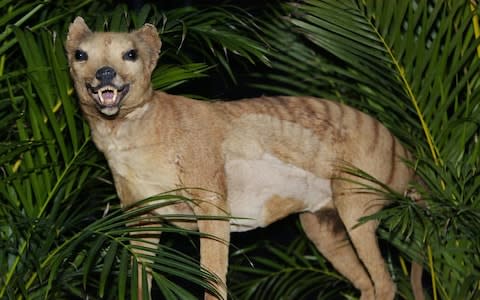Demise of Tasmanian Tiger may be greatly exaggerated after reported sightings of extinct marsupial

More than 80 years since the last thylacine in captivity died and almost 40 years since it was declared extinct, rumours of the Tasmanian Tiger’s survival have been reignited by a newly published document.
The thylacine, or Tasmanian Tiger, was once Australia's top predator but the last one in captivity died in 1936.
Tasmanian officials say “there is no evidence to confirm the thylacine still exists” but a document published this week by the Department of Primary Industries, Parks, Water and Environment (DPIPWE) features numerous accounts from farmers, bushwalkers, tourists and others claiming to have seen the striped carnivore over the past three years.
The Department received eight reports in that period of thylacine sightings, sometimes of an adult with cubs, and usually at dusk or dawn in the northern and western parts of the island state.
Two Western Australian tourists recorded in the document said they saw a striped animal the size of a “large kelpie” in February last year and were “100 per cent certain” it was a Tasmanian Tiger.
In April 2017 a motorist included in the document said he saw a thylacine run across the Murchison Highway. “If it was a cat, it was a bloody big one,” he said.
Engravings and rock art by Aboriginal people depicting the thylacine have been found dating back to before 1000 BC, and it is believed some depictions of the animal are much older, including in the north of Western Australia - as far away from Tasmania as possible in Australia.

It is believed some of the art depicts efforts by the Aboriginal people to save the species on the mainland.
However, the Tiger was already extinct on the mainland by the time Europeans first arrived. Abel Tasman’s party recorded seeing footprints of “wild beasts having claws like a tiger” in Tasmania in 1642.
The mature thylacine ranged from 100 to 130 cm long, with a tail of around 50 to 65cm, and about 60cm tall, and weighing up to 30kg. After claims the animal was attacking sheep, the Van Diemen's Land Company introduced bounties on the thylacine in 1830.
From 1888 and 1909 the Tasmanian Government paid £1 per head for dead adult thylacines and ten shillings for pups. Farmers, bounty hunters, wild dogs introduced by Europeans, destruction of habitat, disease, and the extinction of animals on which the tiger fed all contributed to the dramatic fall in the animal’s population.
Thylacine expert Col Bailey told the Australian Broadcasting Corporation that he saw a Tasmanian Tiger 50 years ago on a river bank while canoeing.
“I'm sure they're not extinct… this (document) has shed a bit of light," he said.
Mr Bailey said the fascination with the Tasmanian Tiger was partly motivated by a sense of guilt that previous generations had driven the species to the brink of extinction, if not beyond.
The thycaline was officially declared extinct in 1982, and the DPIPWE issued a statement that for more than 50 years there have been no officially confirmed sightings of the animal. "The Department will continue to record information on reported sightings,” it added.

 Yahoo News
Yahoo News 